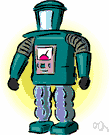golem
(redirected from Golems)Also found in: Thesaurus, Encyclopedia.
go·lem
(gō′ləm)n.
In Jewish folklore, an artificially created human supernaturally endowed with life.
American Heritage® Dictionary of the English Language, Fifth Edition. Copyright © 2016 by Houghton Mifflin Harcourt Publishing Company. Published by Houghton Mifflin Harcourt Publishing Company. All rights reserved.
golem
(ˈɡəʊlɛm)n
(Non-European Myth & Legend) (in Jewish legend) an artificially created human being brought to life by supernatural means
[from Yiddish goylem, from Hebrew gōlem formless thing]
Collins English Dictionary – Complete and Unabridged, 12th Edition 2014 © HarperCollins Publishers 1991, 1994, 1998, 2000, 2003, 2006, 2007, 2009, 2011, 2014
go•lem
(ˈgoʊ ləm, -lɛm)n.
(in Jewish folklore) a figure artificially constructed in the form of a human being and endowed with life.
[1895–1900; (< Yiddish goylem) < Hebrew gōlem shapeless thing]
Random House Kernerman Webster's College Dictionary, © 2010 K Dictionaries Ltd. Copyright 2005, 1997, 1991 by Random House, Inc. All rights reserved.
ThesaurusAntonymsRelated WordsSynonymsLegend:
Switch to new thesaurus
| Noun | 1. |  golem - (Jewish folklore) an artificially created human being that is given life by supernatural means golem - (Jewish folklore) an artificially created human being that is given life by supernatural meansfolklore - the unwritten lore (stories and proverbs and riddles and songs) of a culture Judaism - the monotheistic religion of the Jews having its spiritual and ethical principles embodied chiefly in the Torah and in the Talmud mythical being - an imaginary being of myth or fable |
| 2. |  golem - a mechanism that can move automatically golem - a mechanism that can move automaticallymechanism - device consisting of a piece of machinery; has moving parts that perform some function |
Based on WordNet 3.0, Farlex clipart collection. © 2003-2012 Princeton University, Farlex Inc.